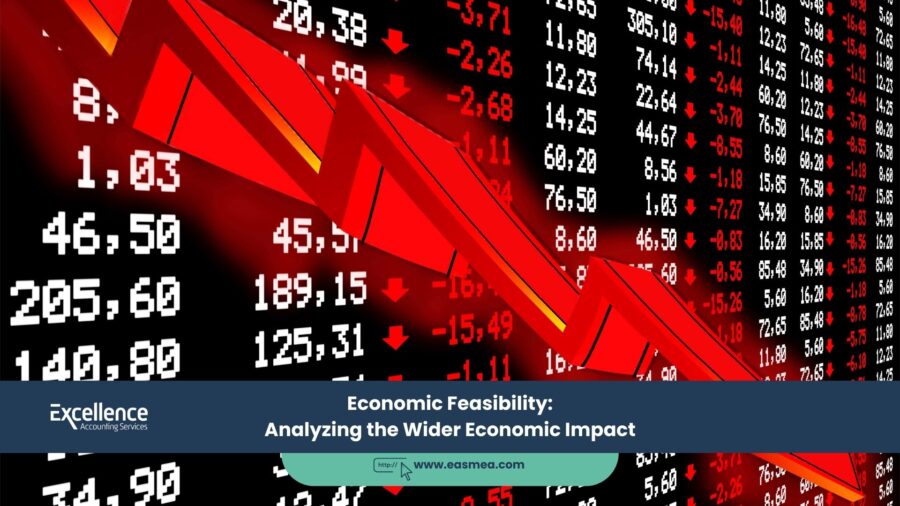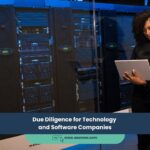Economic Feasibility: Analyzing the Wider Economic Impact of a Project
When evaluating a new project or investment, the most obvious question is: “Will it be profitable?” This is the domain of a financial feasibility study, which focuses squarely on the return on investment (ROI) for the project’s owners and investors. However, for large-scale projects, especially those involving public funds or significant community impact, there is a broader and equally important question: **”Is this project good for the wider economy?”** This is the central question of an **Economic Feasibility Study**.
- Economic Feasibility: Analyzing the Wider Economic Impact of a Project
- The Crucial Difference: Financial vs. Economic Feasibility
- Core Components of an Economic Feasibility Study
- Comprehensive Feasibility Studies with Excellence Accounting Services (EAS)
- Frequently Asked Questions (FAQs)
- Planning a Project with Community Impact?
Economic feasibility looks beyond a project’s balance sheet to analyze its overall impact on a community, region, or country. It assesses the costs and benefits to society as a whole. This type of analysis is crucial for government bodies evaluating infrastructure projects, for developers seeking public support for a new real estate venture, and for any organization that needs to understand and articulate its broader socio-economic contribution.
This guide will explain the concept of economic feasibility, how it differs from financial feasibility, and the key components of the analysis, such as cost-benefit analysis and economic impact assessments.
Key Takeaways
- Economic vs. Financial: Financial feasibility focuses on profitability for the investor (private returns). Economic feasibility focuses on the net benefit to the whole economy (social returns).
- It Quantifies Wider Impacts: The study measures impacts like job creation, increased tax revenues for the government, and benefits to local suppliers (multiplier effect).
- Cost-Benefit Analysis is Key: It compares the total economic benefits of a project to its total economic costs, including social and environmental costs that don’t appear on a financial statement.
- Essential for Public Projects: This analysis is a standard requirement for government projects (like a new metro line or park) to justify the use of public funds.
- A Tool for Gaining Support: For private developers, a strong economic feasibility study can be a powerful tool to gain support from government authorities and the local community. A professional feasibility study is essential for this.
The Crucial Difference: Financial vs. Economic Feasibility
Understanding the distinction between these two analyses is fundamental. While they are related and both use financial data, their perspectives are entirely different.
| Aspect | Financial Feasibility | Economic Feasibility |
|---|---|---|
| Core Question | “Is this project profitable for the company/investor?” | “Does this project create a net benefit for the economy/society?” |
| Focus | Private returns (e.g., Net Present Value, IRR). | Social returns (e.g., job creation, GDP growth, environmental impact). |
| Costs Considered | Direct project costs (capital, operating expenses). | Direct costs + External costs (e.g., pollution, traffic congestion). |
| Benefits Considered | Direct project revenues and profits. | Direct benefits + External benefits (e.g., time saved by commuters, increased tourism). |
| Primary User | Private investors, banks, company management. | Governments, public agencies, urban planners, large-scale developers. |
For example, building a new public park is likely to be financially unfeasible—it generates no direct revenue. However, it could be highly economically feasible due to the benefits it provides to the community in terms of health, recreation, and increased property values nearby.
Core Components of an Economic Feasibility Study
A robust economic feasibility study is a complex analysis that incorporates several key methodologies.
1. Cost-Benefit Analysis (CBA)
This is the heart of the study. A CBA attempts to monetize all the costs and benefits of a project from a societal perspective.
- Identifying All Costs: This includes direct construction and operating costs, but also indirect and intangible costs like the environmental impact of construction or the loss of an existing land use.
- Identifying All Benefits: This includes direct benefits (if any) but focuses on indirect and intangible benefits, such as time savings for commuters from a new road, improved public health from a new hospital, or increased tourism revenue for a city from a new landmark.
- Monetization: The most challenging step is assigning a monetary value to these intangible costs and benefits to allow for a direct comparison.
2. Economic Impact Assessment (EIA)
An EIA focuses on how the project will affect the economy of a specific area, typically in terms of jobs, income, and output.
- Direct Impact: The jobs and spending created directly by the project itself (e.g., construction workers, project staff).
- Indirect Impact: The jobs and spending created in the project’s supply chain (e.g., the cement supplier and logistics company that support the construction).
- Induced Impact (The Multiplier Effect): The jobs and spending created when the direct and indirect employees spend their wages in the local economy (e.g., at local restaurants and shops).
3. Analysis of Alternatives
A good study doesn’t just evaluate the proposed project in isolation. It compares it to other alternatives, including the “do-nothing” alternative. This helps policymakers understand the opportunity cost of choosing one project over another.
Comprehensive Feasibility Studies with Excellence Accounting Services (EAS)
Whether your focus is purely financial or requires a broader economic perspective, EAS provides the rigorous analysis needed to make informed investment decisions. Our feasibility studies are trusted by investors, developers, and government entities across the UAE.
- Integrated Feasibility Studies: We conduct comprehensive studies that can cover all aspects of feasibility—market, technical, financial, and economic—giving you a complete picture of a project’s viability.
- Expert Financial Modeling: Our CFO services team excels at building the complex financial models that underpin both financial and economic analyses, from projecting ROI to calculating economic multipliers.
- Objective, Data-Driven Reports: We provide independent, unbiased reports that are essential for securing public support, justifying government investment, and attracting private financing.
- Strategic Business Consultancy: We help you interpret the results of the study and use them to develop a robust business plan and strategic roadmap for your project.
Frequently Asked Questions (FAQs)
No, they are different but related. An Environmental Impact Assessment focuses specifically on the project’s effects on the natural environment (air, water, wildlife). An Economic Feasibility Study has a broader scope, looking at all economic costs and benefits, of which the environmental impact is one important component.
Economists use established methodologies. For example, the value of time saved for commuters is often calculated based on average wage rates. While not perfect, these methods provide a standardized way to compare different types of benefits.
A private developer building a large mall or residential community might commission an economic feasibility study to demonstrate the project’s benefits to the government. By showing the number of jobs that will be created and the additional tax revenue that will be generated, they can make a stronger case for obtaining the necessary permits and approvals.
The multiplier effect refers to the ripple effect of an initial investment throughout an economy. For example, when a new factory is built, it pays wages to its workers (direct impact). These workers then spend their money at local shops (induced impact). The factory also buys materials from local suppliers (indirect impact). The multiplier quantifies this total economic activity generated by the initial investment.
Yes. For example, a factory might be highly profitable for its owner (financially viable), but if it creates significant pollution that harms public health and requires costly government cleanup, its total economic costs could outweigh its benefits, making it economically unfeasible.
Yes, this is very common for public goods. As mentioned, a public park or a new library has huge economic benefits for a community but generates little to no direct revenue, making it financially unfeasible for a private investor. This is why such projects are funded by governments.
The economic feasibility study is conducted at the very beginning of the project lifecycle, before major design and engineering work begins. Its purpose is to justify the project’s existence and secure the initial approval to proceed.
A shadow price is an estimated price for something that is not normally bought and sold in the market, like the cost of air pollution or the value of a clean beach. Cost-Benefit Analysis often uses shadow prices to monetize these intangible costs and benefits.
While most common for large projects, the principles can be applied at a smaller scale. For example, a local business association might conduct a simplified economic impact study to show how a “shop local” campaign benefits the entire town, not just the individual shop owners.
National and local strategic goals are a key part of the context. A project that aligns with strategic objectives—such as diversifying the economy, promoting tourism, or developing a specific technology sector—is more likely to be considered economically feasible and receive government support, as it contributes to the nation’s long-term vision.
Conclusion: A Broader View of Value
In a world increasingly aware of the interconnectedness of business and society, the scope of “viability” is expanding. While financial profitability will always be a critical measure of a project’s success, economic feasibility provides a more complete and responsible picture. It forces us to consider the true costs and benefits of our investments, ensuring that the projects we build do not just enrich their owners, but also contribute positively to the economic and social fabric of the community as a whole.
Planning a Project with Community Impact?
Partner with Excellence Accounting Services to conduct a comprehensive feasibility study that articulates the full value of your project.




